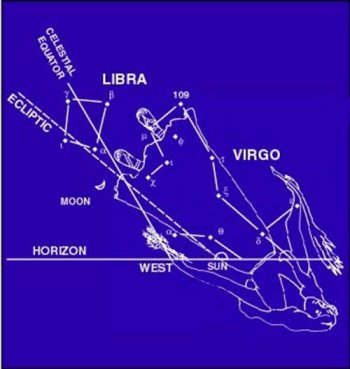The “Great wonder” of Revelation 12:1 Sunset, 6:18 P.M.,
September 11, 3 B.C.
The following diagram shows the sun half-way set. The sun is on the ecliptic, the dotted line, and the solid line is the celestial equator, which is directly overhead at the earth’s equator. At this point, the first thin crescent of the moon appears, marking the first of the new month, Tishri.

The significant celestial events heralding the birth of Jesus Christ began in August of 3 B.C., when Jupiter the king planet became visible above the eastern horizon as a morning star. On August 12, Jupiter came into conjunction with Venus, the bright and morning star in the constellation of Leo, the sign of Judah.
Virgo was the constellation signifying the woman and her seed as prophesied in Genesis 3:15. And on September 11, 3 B.C., the sun was positioned in the midst of Virgo while the new moon was directly under Virgo’s feet—this configuration corresponding exactly to the description in Revelation 12 regarding the Messiah’s birth. This stellar arrangement was visible in Palestine from sunset at 6:18 P.M. until the moon set at 7:39 P.M. Thus it was during this eighty-one minute period on the night of September 11, B.C. that Jesus Christ was born in a stable in Bethlehem.
Revelation 12:1
And there appeared a great wonder in heaven; a woman clothed with the sun, and the moon under her feet, and upon her head a crown of twelve stars:

